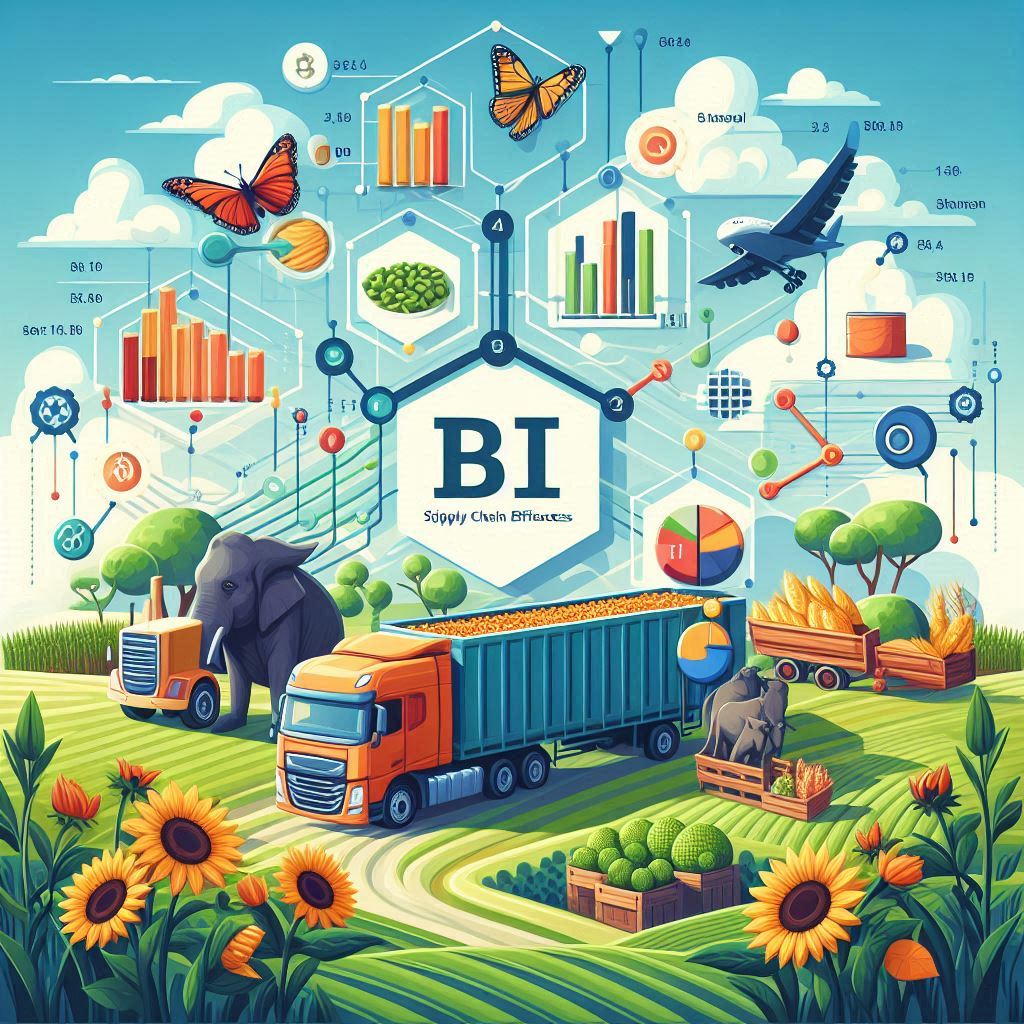In today’s rapidly evolving agricultural landscape, the use of Business Intelligence (BI) is becoming increasingly crucial for improving supply chain efficiency. As the demand for food continues to rise, optimizing supply chain processes is essential to ensure the timely delivery of agricultural products. Using BI to improve supply chain efficiency in agriculture not only enhances productivity but also reduces costs and minimizes waste. This article explores how BI can be leveraged to streamline supply chain operations in agriculture, providing insights into its benefits, implementation strategies, and the future of agricultural supply chains.
The Role of BI in Agricultural Supply Chains
Business Intelligence (BI) involves the use of data analysis tools and technologies to make informed business decisions. In agriculture, BI plays a pivotal role in managing and optimizing supply chains by providing real-time data, predictive analytics, and actionable insights. By harnessing the power of BI, agricultural businesses can monitor crop conditions, track inventory levels, forecast demand, and streamline logistics.
Benefits of Using BI to Improve Supply Chain Efficiency
Real-Time Data Access
One of the most significant advantages of using BI in agriculture is access to real-time data. Farmers and supply chain managers can monitor various parameters such as weather conditions, soil moisture levels, and crop health. This information allows for timely decision-making, ensuring that crops are harvested and transported at the optimal time.
Predictive Analytics
Predictive analytics is another key benefit of BI. By analyzing historical data and identifying patterns, BI tools can forecast future demand, helping farmers and suppliers plan their production and distribution activities more effectively. This reduces the risk of overproduction or underproduction, leading to better resource management.
Cost Reduction
Using BI to improve supply chain efficiency in agriculture also leads to significant cost savings. By optimizing routes, reducing transportation times, and minimizing waste, businesses can lower their operational expenses. Additionally, better inventory management prevents excess stock and reduces storage costs.
Implementing BI in Agricultural Supply Chains
Data Collection and Integration
The first step in implementing BI in agriculture is data collection. This involves gathering data from various sources such as sensors, satellite imagery, and market reports. Once collected, the data needs to be integrated into a centralized system for analysis.
Choosing the Right BI Tools
Selecting the appropriate BI tools is crucial for successful implementation. Tools that offer real-time data analytics, predictive modeling, and customizable dashboards are ideal for agricultural supply chains. Popular BI tools for agriculture include Tableau, Power BI, and QlikView.
Training and Support
For BI implementation to be effective, it is essential to provide training and support to farmers and supply chain managers. This ensures that they can effectively use BI tools to make data-driven decisions. Regular training sessions and continuous support help in maximizing the benefits of BI.
Future Trends in Agricultural Supply Chains
The future of agricultural supply chains is likely to be shaped by advancements in BI and other emerging technologies. Here are some trends to watch out for:
AI and Machine Learning
Artificial Intelligence (AI) and Machine Learning (ML) are set to revolutionize agricultural supply chains. These technologies can analyze vast amounts of data to identify patterns and provide actionable insights. For example, AI can predict pest outbreaks, optimize irrigation schedules, and improve crop yields.
IoT Integration
The Internet of Things (IoT) is another technology that will enhance BI in agriculture. IoT devices such as smart sensors and drones can collect real-time data on crop conditions, soil health, and weather patterns. This data can be integrated with BI tools to provide a comprehensive view of the supply chain.
Blockchain Technology
Blockchain technology offers a secure and transparent way to track the movement of agricultural products through the supply chain. By recording every transaction on a decentralized ledger, blockchain ensures the traceability and authenticity of products, reducing the risk of fraud and improving food safety.
Conclusion
Using BI to improve supply chain efficiency in agriculture is a game-changer for the industry. By leveraging real-time data, predictive analytics, and advanced BI tools, agricultural businesses can enhance productivity, reduce costs, and minimize waste. The future of agricultural supply chains looks promising, with AI, IoT, and blockchain set to further transform the industry. Embracing these technologies will be essential for staying competitive and meeting the growing demand for food.
FAQ
What is Business Intelligence (BI)?
Business Intelligence (BI) refers to the use of data analysis tools and technologies to make informed business decisions. It involves collecting, integrating, and analyzing data to provide actionable insights.
How does BI improve supply chain efficiency in agriculture?
BI improves supply chain efficiency in agriculture by providing real-time data, predictive analytics, and actionable insights. This allows for better decision-making, optimized routes, reduced transportation times, and minimized waste.
What are some popular BI tools for agriculture?
Popular BI tools for agriculture include Tableau, Power BI, and QlikView. These tools offer real-time data analytics, predictive modeling, and customizable dashboards.
How can AI and Machine Learning enhance agricultural supply chains?
AI and Machine Learning can analyze vast amounts of data to identify patterns and provide actionable insights. They can predict pest outbreaks, optimize irrigation schedules, and improve crop yields, thereby enhancing agricultural supply chains.
What is the role of IoT in agricultural supply chains?
The Internet of Things (IoT) involves using smart devices to collect real-time data on crop conditions, soil health, and weather patterns. This data can be integrated with BI tools to provide a comprehensive view of the supply chain, improving efficiency and decision-making.
How does blockchain technology benefit agricultural supply chains?
Blockchain technology offers a secure and transparent way to track the movement of agricultural products through the supply chain. It ensures the traceability and authenticity of products, reduces the risk of fraud, and improves food safety.



